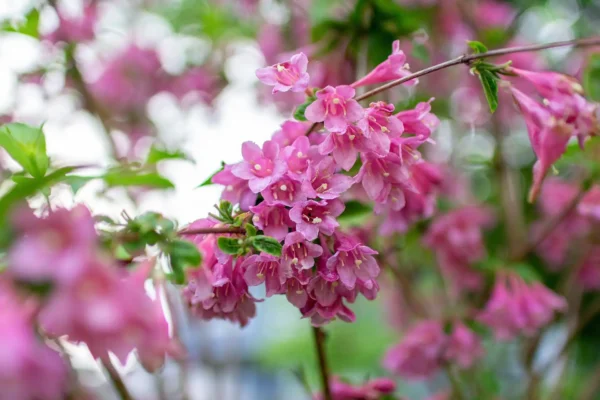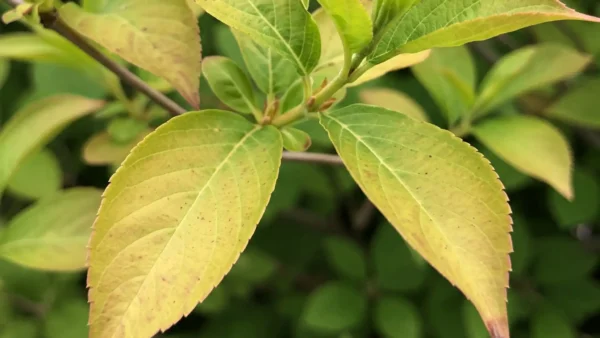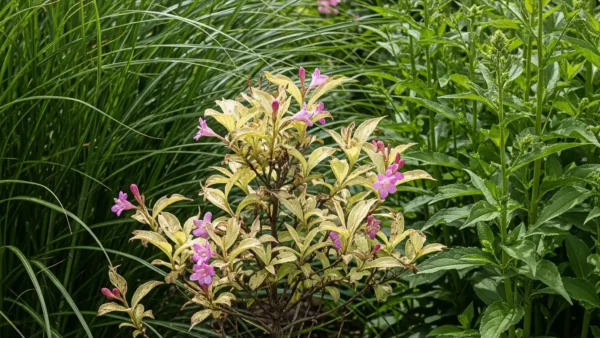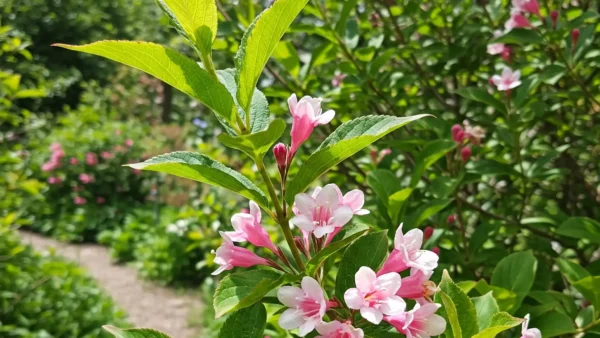My Weigela Looks Dead: 5 Steps to Diagnose and Revive Your Shrub
A lot of gardeners have had the same emotion when they walk out in late spring and see that their magnificent Weigela appears lifeless while everything else is bursting with green. It’s a moment of total panic. Your mind races: Is it gone for good? Did I make a mistake? Should I pull it out and hide the proof? But before you pick up the shovel, take a big breath and stop.
One May, I was terrified when my cherished “Wine & Roses” Weigela, a shrub I had cared for for years, was still just a bunch of dead-looking sticks. I’ll never forget how scared I was. The forsythia nearby was a riot of yellow, and the tulips were in full bloom. This made my Weigela’s sparse limbs look even worse. I immediately thought the worst and started to dig its grave. But a quick, two-second test saved its life and gave me a lesson in patience. Most of the time, a shrub in this condition isn’t dead; it’s just having a frequent problem that can be fixed, such winter dieback. To be sure, the first thing you need to do is a basic “scratch test.” Let me show you what I did.
Step 1: Don’t freak out! Do the Scratch Test First
This one, simple test will give you a clear answer before you do anything else. For every woody plant, from roses to maple trees, it’s the most vital diagnostic tool a gardener has. It will tell you right away if your shrub is still alive.
How to Do the Scratch Test:
- Pick a place to start. Pick a branch on your Weigela, starting with one of the younger, higher-up twigs where damage is most likely to have happened.
- Gently peel the bark off. If the stems are young, use your thumbnail. If the branches are bigger, use a small, clean pocketknife. Gently scratch off a little piece of the thin, papery outer bark. You don’t have to dig very deep; just enough to see the layer underneath it.
- Pay great attention to the color. The cambium is the living tissue that makes up this layer. It moves water and nutrients across the plant. The color of the plant shows how healthy it is in that spot.
What the Results Mean:
- Vivid Green: Congratulations! Your Weigela is still alive if you notice vivid green or yellowish-green. This is the hue of living things. The bright green tissue is healthy and moist, which suggests that the branch can still grow new leaves even if it doesn’t have any. It’s the plant’s road for water and nutrients, and when you see green, the road is open.
- Brown or Brittle: If you observe brown, tan, or a brittle gray wood, that part of the branch or branch is dead. Under your nail, it will feel dry and dusty, and the wood can be so weak that it breaks easily. That part is dead, and it won’t grow new leaves.
Don’t quit after the first scratch. Like a detective, work your way down the shrub, doing the scratch test on different branches and getting closer to the plant’s root. A lot of the time, you’ll see a definite pattern: the upper parts that are exposed to the winter wind are brown and dead, while the lower, thicker, and more protected stems are still bright green. This is a classic symptom of winter dieback, and it’s very common with Weigela. It shows you exactly what to cut and what to keep.
Step 2: Find the Cause—The 4 Most Common Reasons a Weigela Looks Dead
You can breathe a sigh of relief if you see green. Your shrub is still alive, but it’s having a hard time for a reason. Finding out what caused the situation is the first step in making the correct rescue plan and stopping it from happening again next year. These are the four most common reasons.
| Reason | Main Signs | Best First Step |
|---|---|---|
| Winter Dieback | The top branches are barren and fragile, and when you scratch them, they become brown. The lower branches and base are green. | Patience and Trimming |
| Stress from Drought | Branches are all brittle, leaves (if there are any) are withered or crispy, and the soil is dry and hard. | Watering Deeply |
| Shock from Transplanting | Shrub was planted less than a year ago; it is reluctant to leaf out and is wilting. | Watering deeply and being patient |
| Pests and Diseases | Specific cankers, patches on stems, or signs of damage from bugs. | Diagnosis and Specific Treatment |
Reason 1: Most Likely, Winter Dieback
This is by far the most prevalent reason why a Weigela looks dead in the spring. Weigela bushes are usually tough, although the flower buds that grow on old wood from the year before can be weaker than the plant itself. A very cold winter, a “false spring” warm spell followed by a sudden hard frost, or strong, drying winter winds can damage the exposed tops of the branches. But the base is often better protected and the roots are strong, so they stay healthy and sheltered by the soil. Because of this injury, the plant takes a long time to wake up. It waits until it thinks the weather is stable before spending energy on new growth.
Reason 2: A lot of stress from the drought
A shrub can get quite dry before winter if it has a long, dry summer or a fall with no rain. The plant can’t handle the drying impacts of winter wind and frozen ground if it doesn’t have enough moisture stored in its tissues. This drying out can destroy whole branches, not just the ends. The branches will feel very fragile and may break easily without bending. To inspect, put your finger a few inches into the ground around the base. If it’s dusty and dry, drought is probably a factor.
Reason 3: Shock from the transplant
Did you plant your Weigela last year? If so, it could be going through transplant shock. Moving a shrub will always hurt its fragile feeder roots. After that, the plant has to use all of its energy to grow back that important root system. It doesn’t have much energy left over to make leaves and blossoms, therefore it’s one of the last plants in your garden to wake up. The plant is going through a lot of stress right now, but it will get better.
Reason 4: Less likely to be disease or pests
Weigela are usually strong, however they can have issues from time to time. Fungal infections like twig dieback can make individual branches wilt and die very quickly, sometimes with a “shepherd’s crook” hook at the end. Root rot happens when the soil is too wet and doesn’t drain well. It will cause the plant to slowly die and the crown to get mushy at the soil line. You should also examine for scale insects on the stems. They look like little, hard bumps and can kill the plant. These problems aren’t as widespread as environmental stress, but they need a more focused solution.
Step 3: The Rescue Plan: How to Bring Your Weigela Back to Life
It’s time to do something now that you know what’s going on. The goal of this rescue strategy is to get rid of the dead and damaged components and give the remaining portions the help they need to heal and grow.
Cutting for New Growth
This is the most crucial and active element of getting better. Pruning does more than just clean up the plant; it also gets rid of dead wood that can spread disease and tells the plant to cease wasting energy on tissues that are no longer useful. This lets it focus all of its energy on pushing fresh, healthy growth from the living parts.
- Wait for the buds to get bigger. The worst thing you can do is cut them too soon. Wait until you can see little leaf buds starting to swell on the stems. These buds will be full and may have a tint of green or red in them, depending on the type. This plant is showing you exactly where the live wood is, so you don’t have to guess.
- Find the live and dead wood. Start at the tip and work your way down. You will be able to see exactly where the dead, brittle wood with no buds joins the supple, live wood with its swelling buds.
- Make Your Cuts. Use clean, sharp bypass pruners to clip the dead branch back to about 1/4 inch above the top side shoot or leaf bud that is still alive. Cut at a small angle so that water can run off. Cut off a dead branch all the way to the main stem at its base. Cut all the dead branches back to around 4–6 inches from the ground to help new growth come from the root.
A Gardener’s Tip
I always follow the “Fourth of July Rule” for shrubs that grow their leaves late, like Weigela. I don’t decide for sure if a bush is dead until early summer. They can often surprise you by suddenly sprouting new growth from the base long after you’ve given up hope.
Watering Deeply
It is very important to water a shrub correctly if it is going through drought or transplant shock. Don’t only spray the top for five minutes; this makes the roots weak and shallow. Instead, let a hose run slowly at the base of the plant for 20 to 30 minutes. This lets the water sink into the ground all the way to the roots, which makes them grow deeper and stronger. This makes the plant stronger in the long run. Do this once a week while it’s dry until the plant starts to look better.
The Strength of Patience
The last and most important thing you need is time after you’ve pruned and hydrated. Like a person healing from an injury, a plant needs a lot of stored energy to push out new growth from old wood or its root. It won’t happen right away. Be patient and keep an eye on the plant to see whether fresh green shoots come up from the lower stems or the crown. The fresh growth means that your rescue mission worked.
Step 4: How to Keep Your Weigela Safe in the Future
A little bit of prevention is worth a lot of treatment. You may take a few simple precautions now to make sure your Weigela stays strong and healthy so you don’t have to go through this spring stress again.
- Sunlight is Key: When you first plant your Weigela, make sure it gets at least six hours of direct sunlight every day. Strong, powerful stem development and lots of flowers happen when the sun is out all the time. A robust, strong plant can always take the hardship of winter better than a weak, spindly one that is growing in too much shade.
- Mulch is Your Friend: Put a 2- to 3-inch layer of organic mulch (such shredded bark, wood chips, or compost) around the base of the shrub, but make sure to leave a few inches between the mulch and the main stems so they don’t rot. For soil, mulch is like a superhero. It keeps the roots warm in the summer and cold in the winter, and it stops the freeze-thaw cycles that can lift plants out of the ground.
- Fall Watering: This is probably the most crucial time of year to water your plants. Make sure your shrub is well-watered before winter. If the fall is dry, water your Weigela deeply and for a long time before the ground freezes. A plant that is well-watered is like a camel with a full hump; it has enough water to get through the long, dry winter.
Step 5: When to Say Goodbye—How to Tell If It’s Really Dead
Sometimes, no matter how hard we try, a plant is really gone. If you’ve scratched all the main stems of your Weigela all the way down to the base of the plant at the soil line and only discovered brown, brittle, dried wood, then your plant is dead.
It’s always sad to lose a plant, but it’s also a chance to start over. If you liked your Weigela, you might want to plant a new one. If you think winter damage might be to blame, you could try a cultivar that is more resistant to cold, like “Fine Wine” or “Spilled Wine,” which are recognized for being very hardy. Or, think of it as an opportunity to try a different shrub that blooms in the spring and might work better in that part of your garden.
Questions That Are Often Asked
Why does my Weigela have flowers but no leaves?
This is a classic symptom of a lot of stress, usually because of a lot of damage in the winter. The flower buds on some plants can handle the cold a little better than the leaf buds. The plant knows it’s in jeopardy, so it’s using all of its energy to flower in a last-ditch effort to make seeds and reproduce. The good news is that the stems are still alive. After the plant blooms, cut it back and take good care of it. It will very probably grow back and make leaves.
Should I give a Weigela that seems dead fertilizer?
No. A lot of people think this is true, and it’s easy to see why. We want to help, and fertilizer seems like a way to do it. Fertilizer is not medicine; it is sustenance for a plant that is healthy and thriving. Putting synthetic fertilizers on a shrub that is stressed, dormant, or having trouble can really hurt it. The salts in the fertilizer can hurt the roots that are already hurt and make the plant even more stressed. Don’t even think about fertilizing until you see strong new growth.
How long should I wait for my Weigela to grow leaves?
Weigela are known for taking a long time to wake up in the spring, often weeks after other shrubs. In colder places, they don’t usually start to show signs of life until late May or perhaps early June. This is normal for this kind of animal. Don’t give in to the impulse to panic and cut too soon. Your most important instrument is patience.
Ending
When a Weigela seems dead, a gardener’s best friends are patience and the scratch test. That moment of panic that makes your heart stop is frequently only the start of a simple and satisfying rescue mission. Most of the time, all you need to do to bring your gorgeous shrub back to life is to strategically cut it to get rid of winter damage, water it properly, and give it a lot of time. It will frequently be stronger and more vibrant than before.
Don’t let these problems get you down. Every time you figure out what’s wrong with something, master a new talent, or nurse a plant back to health, you get better at what you do. These are the times that turn you from a person who just owns plants into a real gardener who knows what they’re doing and is secure in their abilities.
Sources
Royal Horticultural Society (RHS): The RHS website offers extensive advice on Weigela care, including pruning, planting, and common problems. This is a reliable source for horticultural information. RHS – Weigela
Missouri Botanical Garden: This botanical garden’s website provides detailed plant information, including growing tips and problem diagnosis for Weigelas. Missouri Botanical Garden – Weigela
University of Minnesota Extension: Extension websites are excellent resources for regional gardening advice. This source provides practical tips for managing Weigelas, especially in areas with harsh winters. University of Minnesota Extension – Shrubs for Minnesota
HGTV: HGTV’s gardening section provides simplified, easy-to-understand guides on plant care, including Weigelas. HGTV – Growing Weigela









